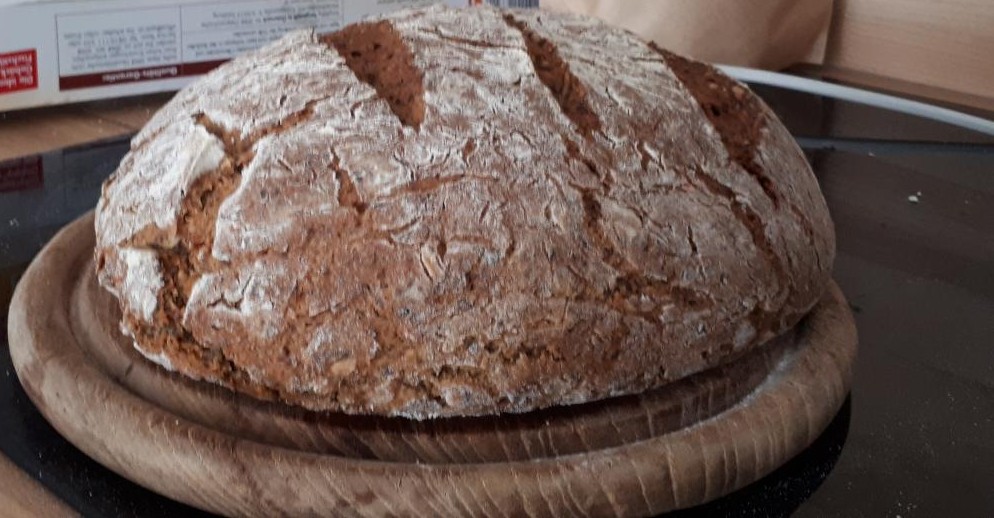Photo: Restaurants will serve makgeolli from a teapot and metal bowls
Makgeolli is an unfiltered rice wine that originated in Korea. It is brewed by combining cooked sweet rice (chapssal) with a grain-based (typically wheat or barley) starter known as nuruk. The relative simplicity of the recipe and resistance to contamination of a well established brew makes makgeolli a good candidate for brewing at home, a good thing given that traditionally brewed makgeolli is difficult to find and most of what's commercially available is crap, having been sweetened with aspartame and potentially ruined with other added flavorings.
The origins of makgeolli are obscure, given that humans have been turning grains into booze for as they've had grains. Ancient accounts of Chinese winemaking suggest that the early recipes involved chewing rice to a paste to introduce salivary amylase enzyme to break down the starches into yeast-available sugars. The discovery of Aspergillus oryzae, a rice mold that also produces amylase among many other useful enzymes, therefore must have been a key labor-saving innovation and key component of making the process substantially less gross. While Japanese brewers ended up isolating and carefully cultivating Aspergillus as koji, taking advantage of its proteases to simultaneously make soy sauce and miso, Korean brewers took a more improvisational approach, wrapping wheat flour cakes in rice straw to inoculate them with a suite of molds, bacteria, and yeasts, Aspergillus crucially among them. Makgeolli brewing is therefore two processes in parallel, Aspergillus breaking the rice down into sugar and yeasts fermenting that sugar into alcohol. The various groupies and hangers on will also produce aromatic compounds and organic acids. Under good conditions these bonus chemicals can lead to a floral aroma and tart acidity; under bad ones, they can include butyric acid, which smells like vomit.
The relatively uncontrolled nature of the fermentation yields a beverage with a high initial starch content. If the starches are allowed to naturally settle, the final result is a clear, sake-like beverage (cheongju, "clear alcohol") and the thick, chalky lees (takju, "cloudy alcohol"). Makgeolli originated as peasant beverage, created by mixing the takju with water to form a milky, low-alcohol beverage that had decent quantities of B vitamins and could take the edge of an afternoon in the fields when consumed during lunch, while the cheongju was primarily consumed by the nobility or distilled to produce soju, one of the world's most widely consumed liquors. Modern makgeolli often consists of the takju and cheongju combined (wonju), has with a final alcohol content ranging from strong beer to barleywine (although higher levels are eminently achievable if for some reason you want).
Pasteurizing wonju is discouraged because it can lead to a loss of flavor, and so it is typically bottled raw. Because there's still starch in the product, it will continue to ferment in the bottle. This has the benefit of creating a nice effervescence as the bottled wine continues to age, and the disadvantage of said effervescence reaching explosive levels if the wine is allowed to age too much. Seriously, I was wiping it off myself, the ceiling, the wall on the other side of the kitchen, and the light fixtures. Burp your bottles.
Makgeolli has been undergoing a revival recently as young people develop an interest in craft or microbrewed alcohol, and it has a small but devoted following in the English speaking community. A well-written and engaging primer for making your first batch can be found for free on the internet . A brief summary of the recipe for making a one-step brew (danyangju) is below:
To make makgeolli, you need:
- A brewing vessel made of glass or food safe plastic; if you feel fancy, you can also get a hangari or traditional Korean brewing pot.
- 1kg Sweet rice
- 100g Nuruk (available on Amazon or at a well stocked Korean grocery store)
- 1L Water (tap water is fine if given a few hours for the chlorine to evaporate off)
- Steaming equipment
- Mochiko or similar rice flour (optional)
- Wine yeast (optional)
- Two 1L bottles - glass stopper bottles and plastic sparkling water bottles both work well; the latter especially so because you can gauge the pressure.
- Sanitizing solution for brewing
-A nylon filter bag
The most basic way to kick things off is to soak your sweet rice for a couple hours, drain for 30 minutes, and then steam in a bamboo steamer lined with a coarse rice steaming cloth for 40 minutes, until just on the al dente side of fully cooked. I have had success using an instant pot with a silicone steamer basket to keep it off the bottom for 4 minutes at high pressure followed by 6-8 minutes of natural release. Once steamed, the rice must be cooled.
The nuruk is broken up and dried and can come a little clumpy; soaking it 200 mL of water for a couple hours beforehand can help activate it and break up the chunks. You can also add wine yeast to improve the alcohol content and help keep the rowdier bacteria in line.
Let the rice cool, flipping it around occasionally to keep it from getting mushy on the bottom and sterilize your vessel per the solution manufacturer's directions. Combine your rice and activated nuruk (potentially by hand), then stir a couple times a day for the next two days. Leave the lid on loosely so your aerobic microbes can breathe. The rice will break down as the Aspergillus gets to work, and the whole brew will gradually split into layers over the next week. After about a week, the microbial activity will start to slow down. You can then filter and bottle. Fridging the bottles for another week or so leads to the best flavor. The solids from filtering (lees) can be retained and used to make cookies or in a marinade. Another beverage (moju) can also be made from them.
As an alternative, you can make a juk or porridge by mixing 200 g of rice flour with 800 mL of water and cooking it into a thick paste. Mix the juk with the nuruk and add the rice after the first 48 hours, stirring for another day or so to incorporate everything. Bring the total water to about 1.1-1.2 L when adding the rice. This has produced better results for me as it seems less likely that one of the obnoxious bugs can take over.
Cooler temperatures (around 68 F) tend to produce the best results, so fall in the Northern hemisphere can be a good time to crank out a batch. Happy drinking!
Announcements & Information
Megathreads and spaces to hang out:
❤️ Come listen to music with your fellow Hexbears in Cy.tube
💖 Come talk in the New weekly queer thread
🧡 Monthly Neurodiverse Megathread
💛 Read about a current topic in the news
⭐️ September Movie Thread ⭐️
Reminders:
💚 You can join specific comms to see posts about all sorts of topics
💙 Hexbear’s algorithm prioritizes comments and discussions over upbears
💜 Sorting by new makes your comrades happy
🌈 If you ever want to make your own megathread, you can go here
Links To Resources (Aid and Theory):
spoiler
Aid: 💙 Comprehensive list of resources for those in need of an abortion -- reddit link 💙 Resources for Palestine
Theory:
❤️ Foundations of Leninism
❤️ Anarchism and Other Essays
❤️ Mega upload with theory for many tendencies


Cool national parks and stuff